Risotto is one of those dishes many are intimidated by, and less likely to attempt making. Sure enough, there are many failed attempts out there that aren’t reserved just for amateur cooks, I’ve had my share of horrific examples even in so-called “Italian” restaurants. Either the rice is way overcooked, the risotto is dry and mealy, or on the other end of the spectrum, crunchy on the inside and mushy on the outside.
Years back, I was fortunate enough to work part-time at an Italian cooking studio in NYC for several years run by an Italian woman from Milan, and risotto was on the menu on a regular basis. We had to get comfortable making it because we were teaching it to large corporate groups and by the end of my tenure there I think I could do it in my sleep.
There’s nothing really magical or scary about it, and when you take a bite into a well-made risotto, well… it’s definitely worth standing over the stove for the 20-30 minutes it requires your undivided attention.
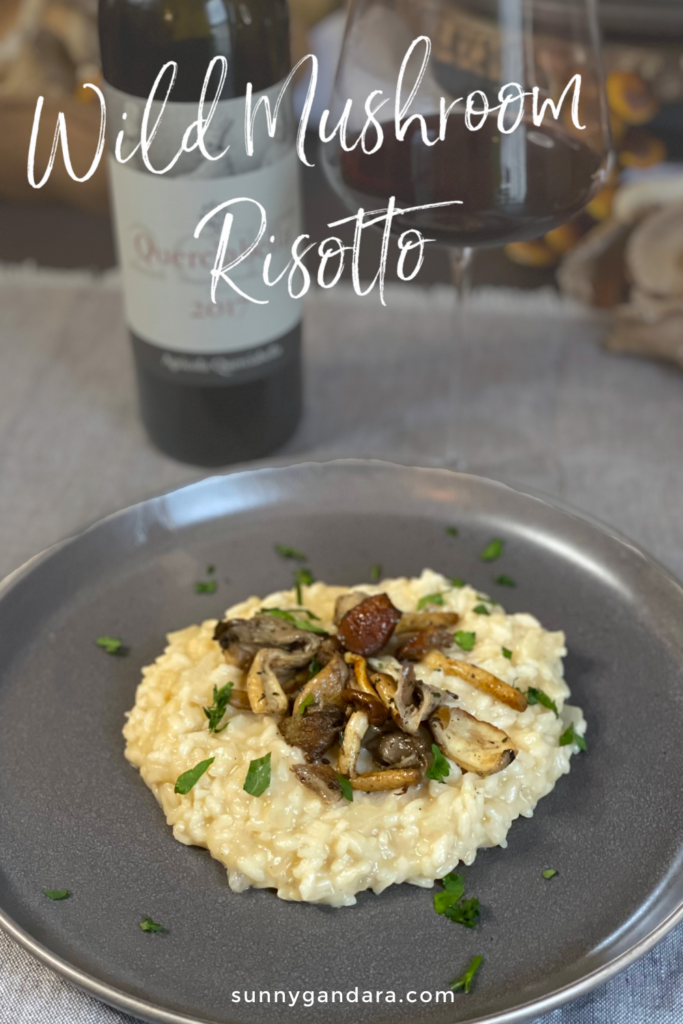
In my mushroom risotto, I love using wild mushrooms of all kinds. There is something about the flavor and texture that is just utterly satisfying, no matter if you follow a plant-based diet or not.
I’m fortunate enough to have local farms in my area that cultivate gorgeous mushrooms and this year I joined a special mushroom CSA (Community Supported Agriculture) and get to pick up a share every weekend at my local farmer market.
For this particular mushroom risotto, I used oyster mushrooms, chestnut mushrooms, and some Lion’s Maine. If you can’t find these particular mushrooms where you are, feel free to use any mushrooms of your choice, ideally a couple of different kinds so you can enjoy the variety of flavors and textures.
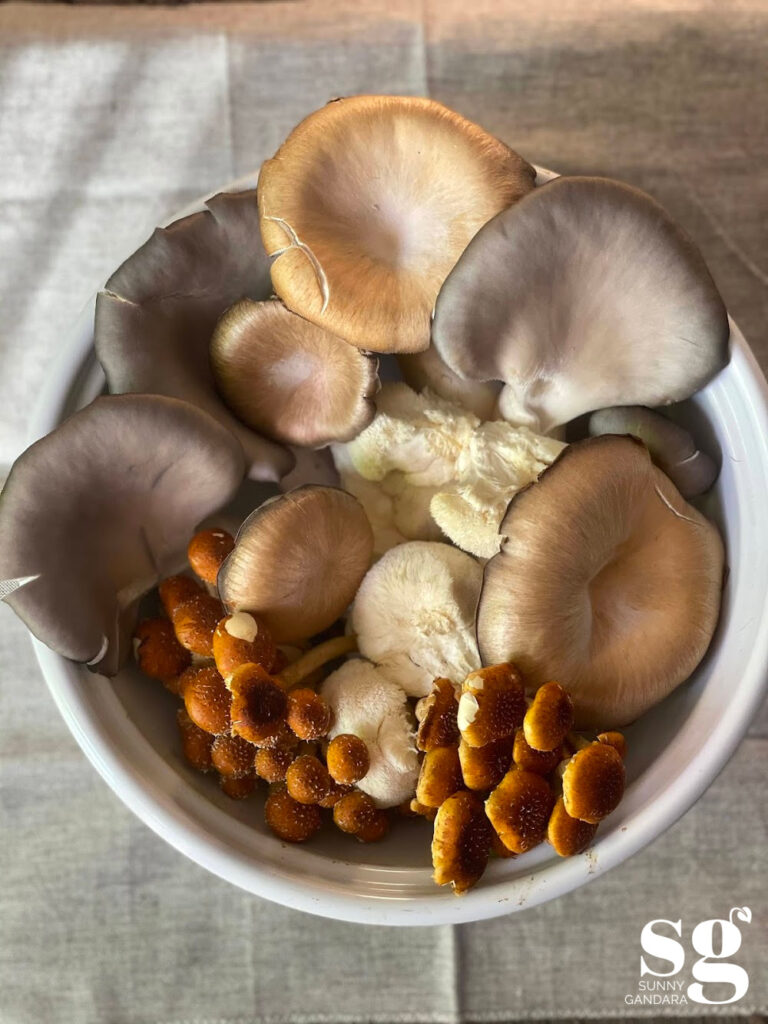
Lions Maine make for a fantastic ‘steak’ or ‘chicken’ if you are looking to impress some meat-eaters and convince them that plant-based eating isn’t half bad 🙂
Besides being a fantastic meat alternative, mushrooms are incredibly healthy and have been used as medicine for thousands of years. They have antioxidant, anti-inflammatory, and anticancer effects and also have the ability to create rich flavors we call umami—often found in animal-based foods.
Try experimenting with mushrooms next time you are cooking, starting with this risotto!
Additionally, you can make a mushroom bolognese sauce, add them to tacos and enchiladas, grill them and make ‘steaks’ and burgers, ‘scallops’ (trumpet mushrooms are great for this!), transform them into crispy ‘bacon’, add them to gravy for a rich, savory flavor, try mushroom meatballs and make a mushroom filling for dumplings and so much more.
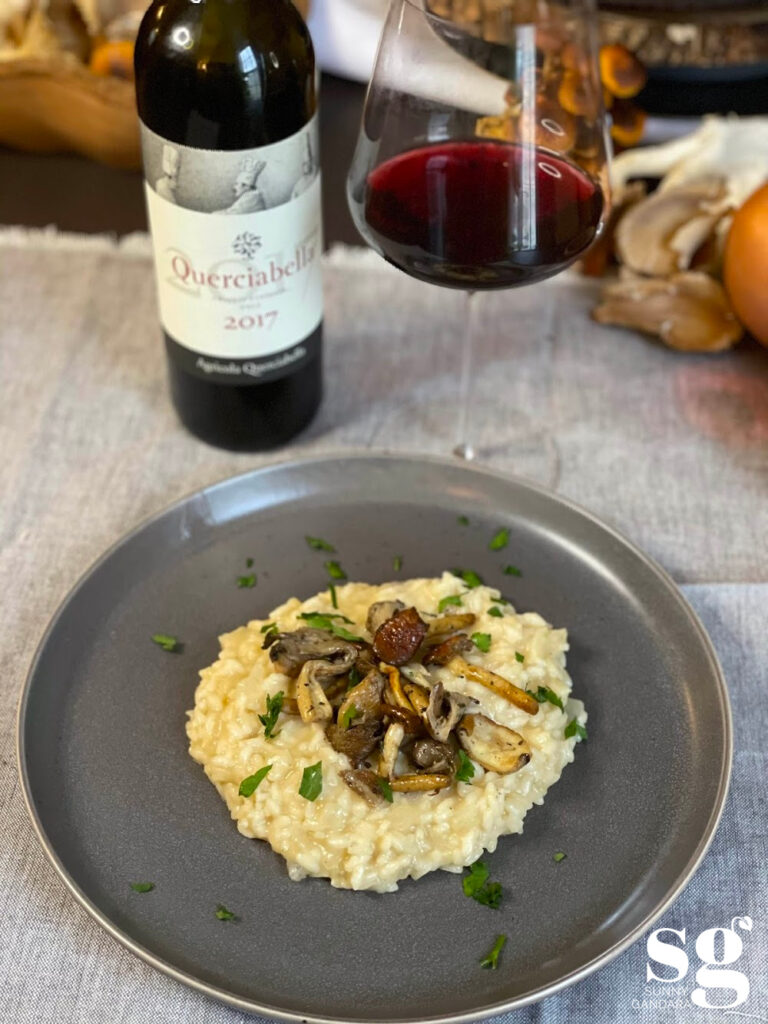
Now that I hopefully have made you feel a bit hungry, let’s think about what to drink with this gorgeous mushroom risotto… My choice fell on Querciabella’s 2017 Chianti Classico, one of my favorite Italian red wines. Full disclosure before you read on: I work for this winery and help market this wine in the United States.
Truthfully, I’ve been enamored with their wines for years even way before I got involved with the company. I’ve always admired the quality of their wines and the way the winery is run, which is very much in line with my ethical and moral values.
Querciabella is a vegan, organic and biodynamic winery—meaning no animal parts are ever used in any stage of winemaking. From the soil to the cellar, the packaging, and how they treat their workers and view their role as part of the environment, their practices are led with respect, kindness, and compassion for all living things and a desire to leave the planet in a better place than we found it.
No pesticides, herbicides, or inferior additives are ever used on the vines or in the juice, and meticulous attention is being made to site selection, vine and soil health, careful hand-harvesting as well as a labor-intensive process of micro vinification once the grapes enter the winery. This means each lot is fermented and aged separately before being blended, aged again (the wine spends 12 months in oak), followed by a rigorous tasting process before the final blend is selected.
What makes this wine so special? Sangiovese is, along with Pinot Noir, one of my favorite red grapes. Maybe it’s because I like their fickle personalities, they demand specific sites, growing conditions, and careful handling, but when they receive what they need, these grapes reward us with some of the finest wines the world knows today. This is most certainly true in Querciabella’s 2017 Chianti Classico.
The 2017 Chianti Classico is made from 100% Sangiovese grown in Chianti Classico’s top three districts: Greve, Radda, and Gaiole. This is a medium-bodied, structured, and beautifully balanced wine with aromas and flavors of expressive red cherries, plums, and raspberries combined with earthy and herbaceous notes, beaming with bright acidity and well-integrated tannins that marry beautifully with the creamy risotto.
The earthiness of the mushrooms mimics the earthiness in the wine and the umami from the miso in the broth brings out the attractive tertiary flavors that come out over time as the wine develops in the glass. Nobody is missing a steak here! There is an attractive softness to the 2017 vintage which makes it instantly enjoyable and accessible, but this wine can definitely age for another decade.
While 2017 might have posed as a challenging vintage, Jancis Robinson, world-famous wine critic, said the 2017 Chianti Classico is “A wine that contradicts the torrid vintage.” I think that exemplifies what Querciabella does—making beautiful wines even in difficult and unusual years. The care, passion, and expertise behind Querciabella’s wines clearly shows and are wines I’d happily drink every day for the rest of my life!
If your interest in Querciabella has peaked and you’re interested in trying these vegan wines out, wine.com carries most of our line-up and they ship nationwide.
Now back to the dish!
A couple of pointers before you start cooking:
1. Care about the rice you use. The quality and creaminess of the risotto will depend on it.
There are several varieties of rice used to make risotto, the most widely available is arborio, which is not as starchy as other varieties and not as efficient at absorbing liquid. Then you have carnaroli, often dubbed ‘the caviar or king of Italian rices’, which in my opinion makes the creamiest risotto and is harder to overcook. There is also vialone nano, commonly seen in the Veneto region, and also produces a very creamy risotto. Baldo, maratelli, and calriso are additional varieties, but the three aforementioned are perhaps the ones you’ll see most often. The problem with most risottos that aren’t made well is that they get mushy on the outside and crunchy on the inside due to uneven cooking.
2. Speaking of uneven cooking: Make sure your stock/broth is warm as you ladle it a little at a time into the rice.
Resist the urge to dump in all the liquid at once. It’s very important to keep the liquid warm and to gradually add the broth. Yes, it will require your standing at the stove for 20 minutes—but once you take a bite into your perfectly cooked risotto, you won’t have minded at all!
3. Use a wide, shallow skillet. This also aids in the even cooking of your risotto.
4. Don’t ever rinse your risotto rice! The starch on the outside is needed to make the risotto creamy, the center of success for the dish!
5. Make sure to cook any toppings (like the mushrooms) separately and not with the rice, to prevent overcooking.
And now I think you’re ready to cook! Buon appetite!
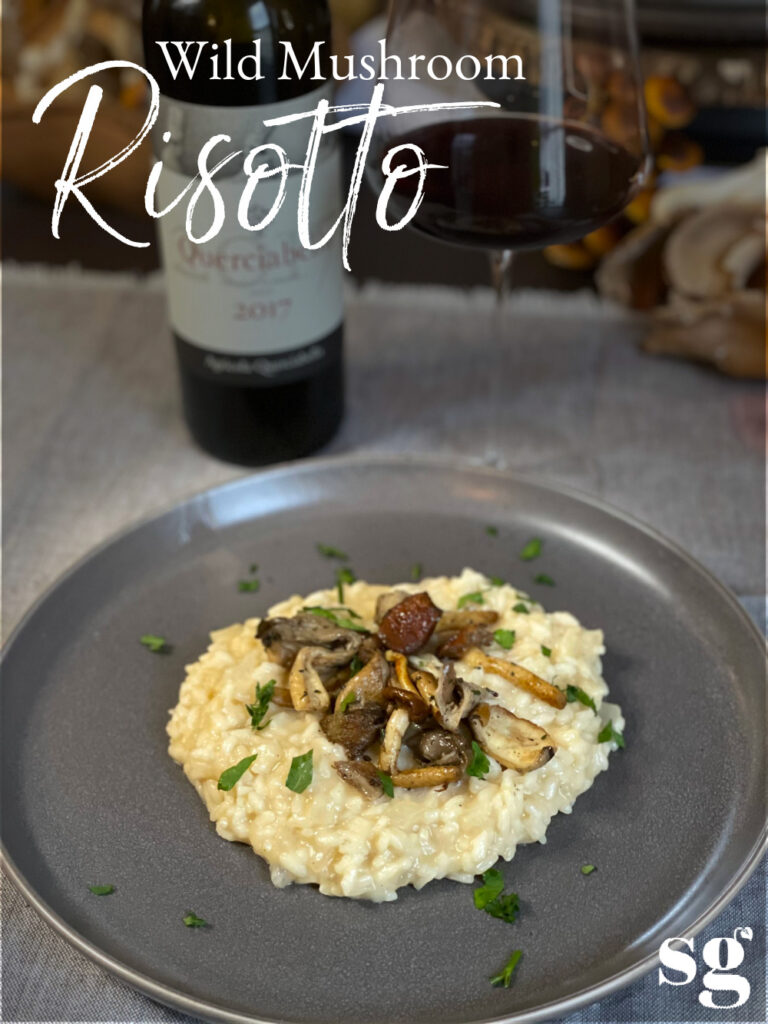
VEGAN MUSHROOM RISOTTO
Serves 4
About 4 cups (1 liter) vegetable broth warmed
2 tablespoons white miso (optional)
4 tablespoons extra-virgin olive oil
8 ounces (225 grams) fresh wild mushrooms, cleaned and sliced
2-3 sprigs thyme stems removed, leaves chopped
1/2 yellow onion, finely chopped (about 1/2 cup)
1 cup (150 ml) Arborio rice
1/2 cup (125 ml) white wine
½ cup (45 grams) grated vegan Parmesan, plus extra for serving (I like the Follow Your Heart or Go Veggie brand, already grated or Violife’s block of parmesan)
1 tablespoon vegan butter (like Earth Balance or Miyoko’s)
Sea or kosher salt and freshly ground black pepper to taste
Handful of flat-leaf parsley, finely chopped, for garnish (optional)
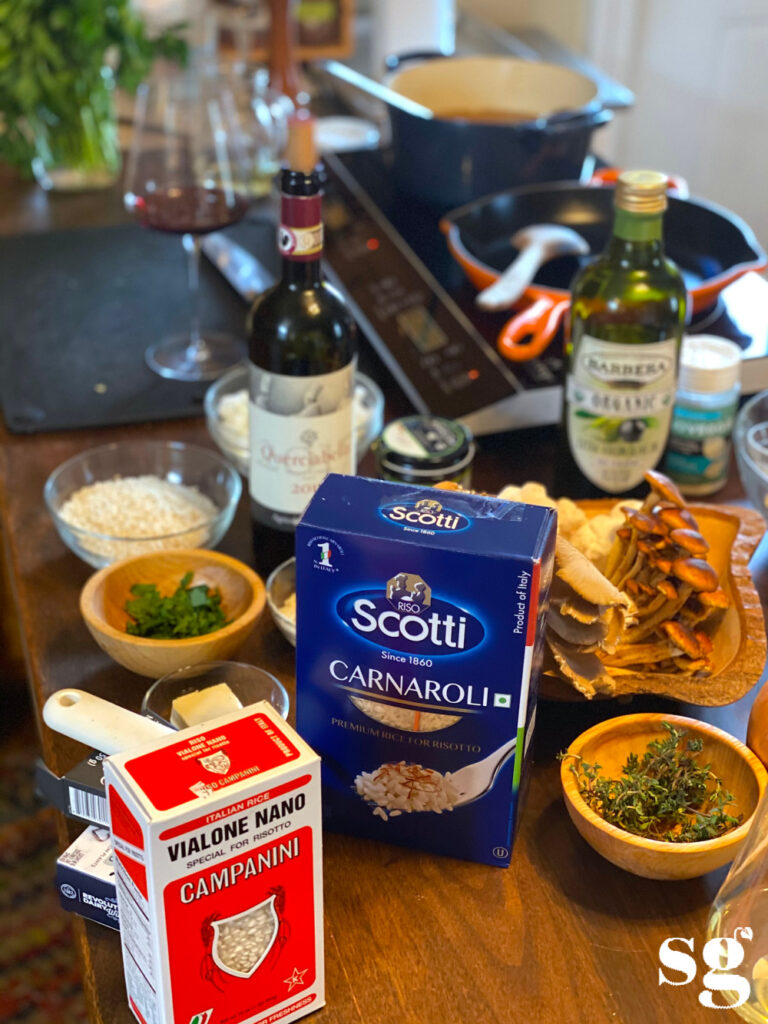
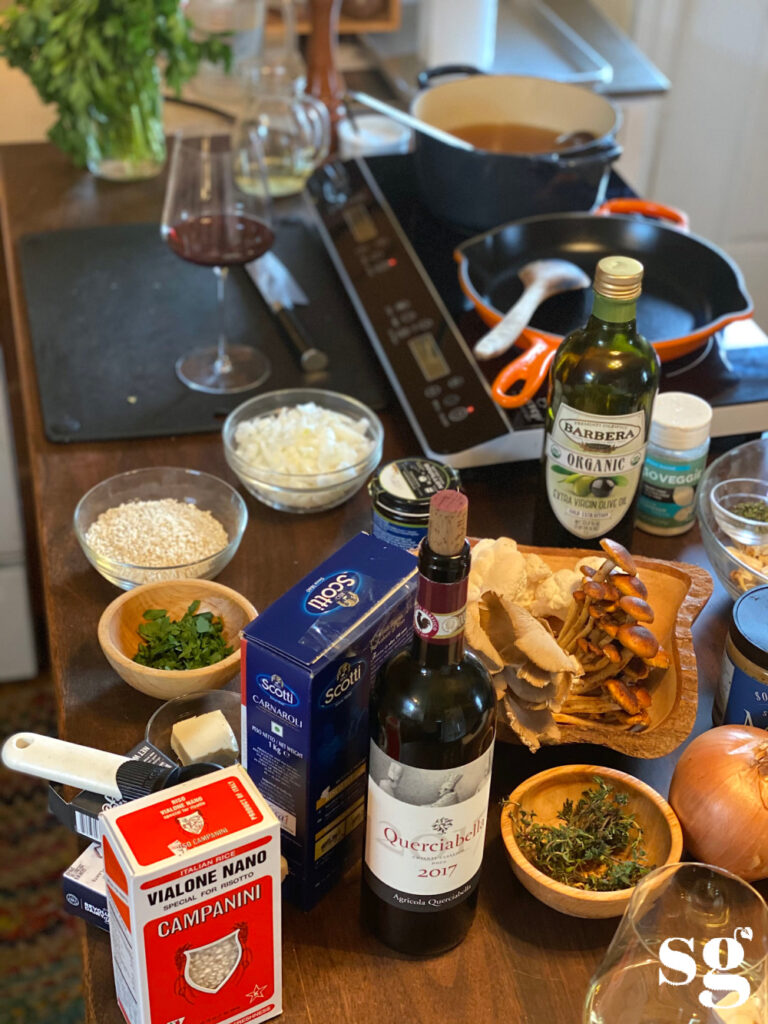
First, pour the broth in a medium pot with the optional miso (adds extra umami flavor) and place over low-medium heat. It’s important to keep the broth warm while gradually ladling it into the risotto to ensure even cooking.
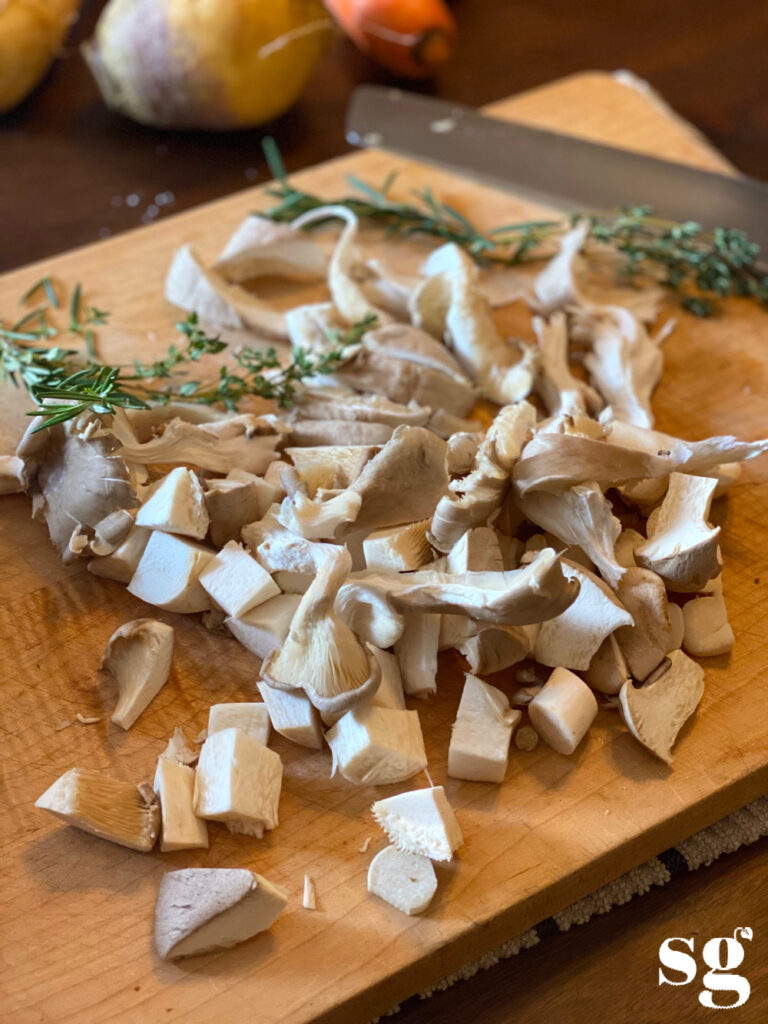
For the wild mushrooms:
In a medium skillet over medium heat, heat 2 tablespoons olive oil and the chopped thyme and heat for about 30 seconds until fragrant, then add the mushrooms.
Cook the mushrooms, stirring frequently until they have slightly browned and released some (but not all) of their water, about 5 minutes. The mushrooms should remain plump, not mushy. Add 2 large pinches of salt halfway through cooking.
Remove the pan from the heat and set the mushrooms aside on a plate.
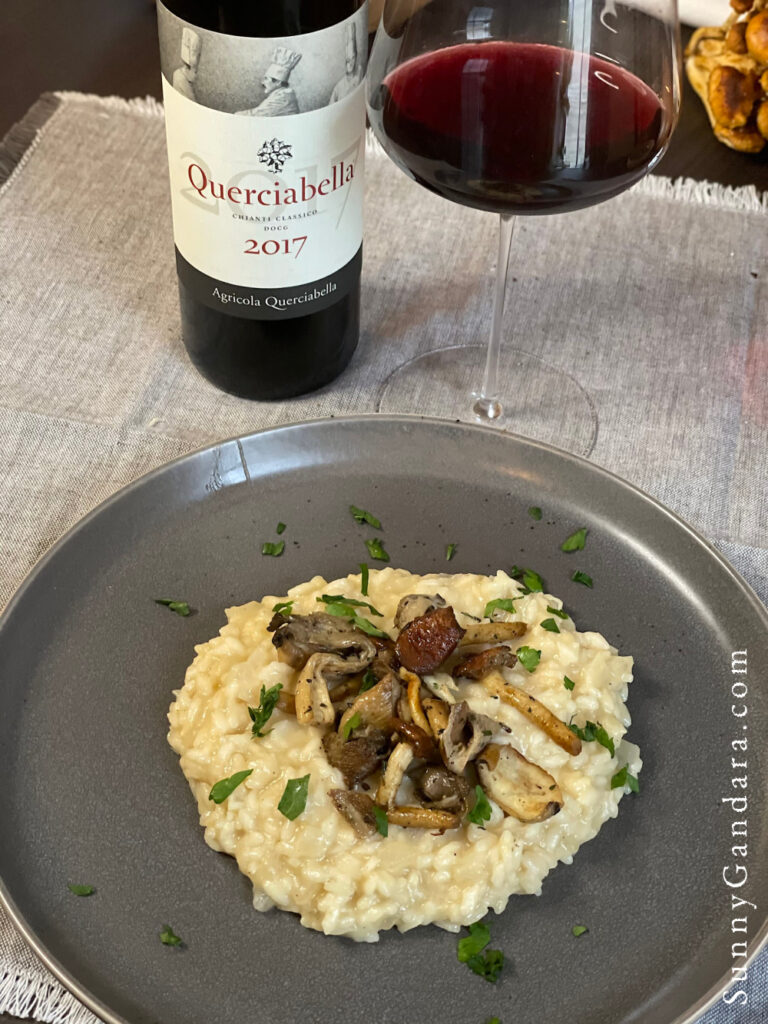
For the risotto:
Place a medium-sized heavy-duty sauté pan over medium heat and add 2 tablespoons olive oil. Toss in the onion and cook until softened and translucent, about 5-10 minutes; be careful to not let the onion brown.
Add the rice and stir well to coat. Continue stirring until the rice is lightly toasted and becomes translucent, about 2 minutes, then add the wine. Stir the rice until the wine evaporates, about 1 minute, then add 1 cup of the broth.
Continue stirring constantly to prevent the rice from sticking to the pan, until the broth has been absorbed, about 3 minutes. Repeat with ladling another cup of broth until almost absorbed, then continue until the rice is cooked, not mushy but has a good texture/consistency and is al dente. The rice should not have absorbed all the liquid but have a little liquid left.
Remove from the pan and stir in the vegan Parmesan cheese and butter.
Season with salt and pepper to taste.
The risotto should be creamy and loose, not firm and dry.
Garnish with chopped parsley if using and pair with Querciabella’s 2017 Chianti Classico!
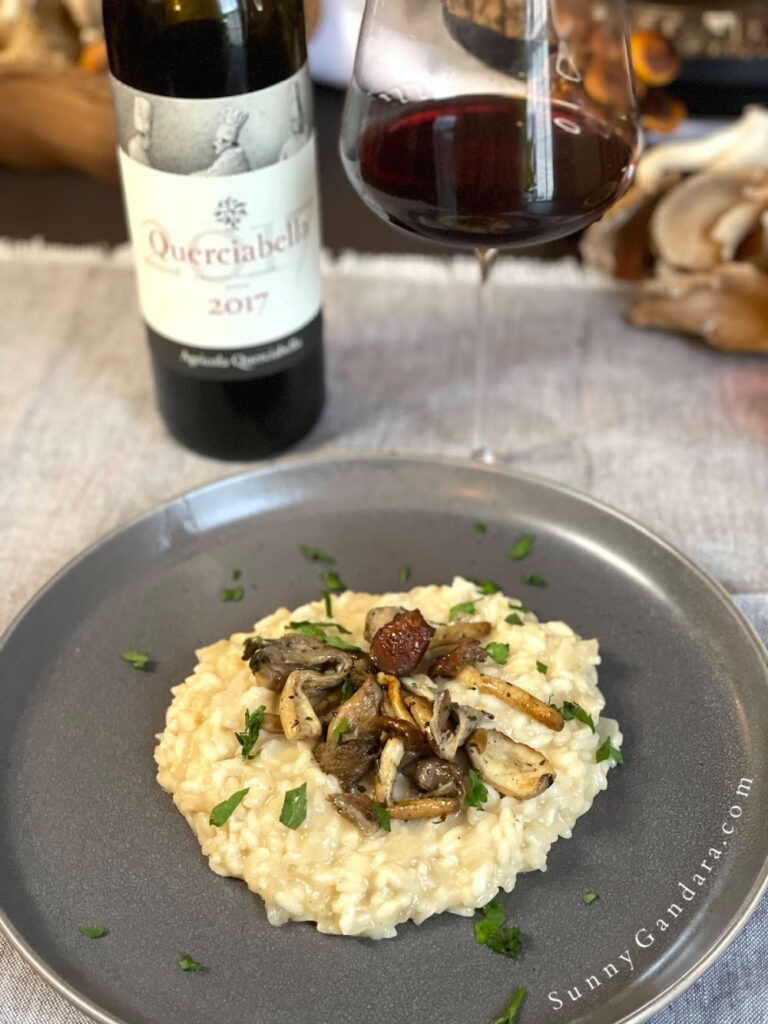
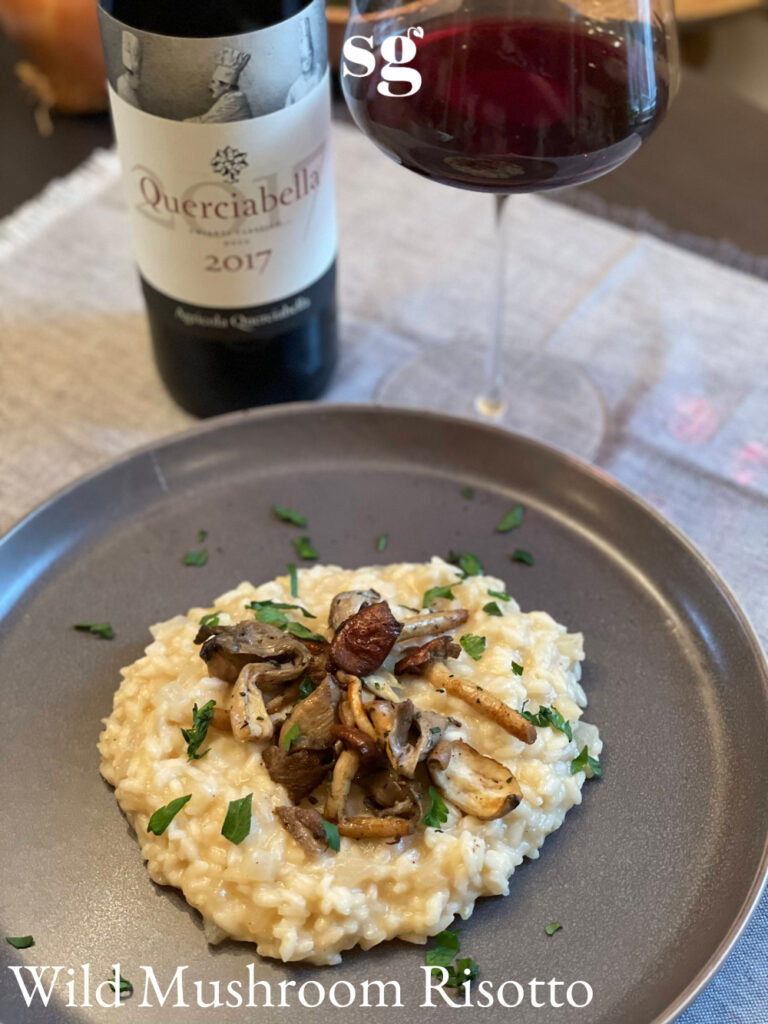
Wild Mushroom Risotto
In my mushroom risotto, I love using wild mushrooms of all kinds. There is something about the flavor and texture that is just utterly satisfying, no matter if you follow a plant-based diet or not. For this particular mushroom risotto, I used oyster mushrooms, chestnut mushrooms, and some Lion’s Maine. If you can’t find these particular mushrooms where you are, feel free to use any mushrooms of your choice, ideally a couple of different kinds so you can enjoy the variety of flavors and textures.
- Yield: 4 1x
- Category: Main
Ingredients
About 4 cups (1 liter) vegetable broth warmed
2 tablespoons white miso (optional)
4 tablespoons extra-virgin olive oil
8 ounces (225 grams) fresh wild mushrooms, cleaned and sliced
2–3 sprigs thyme stems removed, leaves chopped
1/2 yellow onion, finely chopped (about 1/2 cup)
1 cup (150 ml) Arborio rice
1/2 cup (125 ml) white wine
½ cup (45 grams) grated vegan Parmesan, plus extra for serving (I like the Follow Your Heart or Go Veggie brand, already grated or Violife’s block of parmesan)
1 tablespoon vegan butter (like Earth Balance or Miyoko’s)
Sea or kosher salt and freshly ground black pepper to taste
Handful of flat-leaf parsley, finely chopped, for garnish (optional)
Instructions
First, pour the broth in a medium pot with the optional miso (adds extra umami flavor) and place over low-medium heat. It’s important to keep the broth warm while gradually ladling it into the risotto to ensure even cooking.
For the wild mushrooms:
In a medium skillet over medium heat, heat 2 tablespoons olive oil and the chopped thyme and heat for about 30 seconds until fragrant, then add the mushrooms.
Cook the mushrooms, stirring frequently until they have slightly browned and released some (but not all) of their water, about 5 minutes. The mushrooms should remain plump, not mushy. Add 2 large pinches of salt halfway through cooking.
Remove the pan from the heat and set the mushrooms aside on a plate.
For the risotto:
Place a medium-sized heavy-duty sauté pan over medium heat and add 2 tablespoons olive oil. Toss in the onion and cook until softened and translucent, about 5-10 minutes; be careful to not let the onion brown.
Add the rice and stir well to coat. Continue stirring until the rice is lightly toasted and becomes translucent, about 2 minutes, then add the wine. Stir the rice until the wine evaporates, about 1 minute, then add 1 cup of the broth.
Continue stirring constantly to prevent the rice from sticking to the pan, until the broth has been absorbed, about 3 minutes. Repeat with ladling another cup of broth until almost absorbed, then continue until the rice is cooked, not mushy but has a good texture/consistency and is al dente. The rice should not have absorbed all the liquid but have a little liquid left.
Remove from the pan and stir in the vegan Parmesan cheese and butter.
Season with salt and pepper to taste.
The risotto should be creamy and loose, not firm and dry.
Garnish with chopped parsley if using and pair with Querciabella’s 2017 Chianti Classico!
Notes
1. Care about the rice you use. The quality and creaminess of the risotto will depend on it.
There are several varieties of rice used to make risotto, the most widely available is arborio, which is not as starchy as other varieties and not as efficient at absorbing liquid. Then you have carnaroli, often dubbed ‘the caviar or king of Italian rices’, which in my opinion makes the creamiest risotto and is harder to overcook. There is also vialone nano, commonly seen in the Veneto region, and also produces a very creamy risotto. Baldo, maratelli, and calriso are additional varieties, but the three aforementioned are perhaps the ones you’ll see most often. The problem with most risottos that aren’t made well is that they get mushy on the outside and crunchy on the inside due to uneven cooking.
2. Speaking of uneven cooking: Make sure your stock/broth is warm as you ladle it a little at a time into the rice.
Resist the urge to dump in all the liquid at once. It’s very important to keep the liquid warm and to gradually add the broth. Yes, it will require your standing at the stove for 20 minutes—but once you take a bite into your perfectly cooked risotto, you won’t have minded at all!
3. Use a wide, shallow skillet. This also aids in the even cooking of your risotto.
4. Don’t ever rinse your risotto rice! The starch on the outside is needed to make the risotto creamy, the center of success for the dish!
5. Make sure to cook any toppings (like the mushrooms) separately and not with the rice, to prevent overcooking.


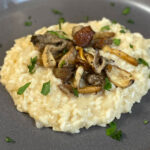

0 Comments